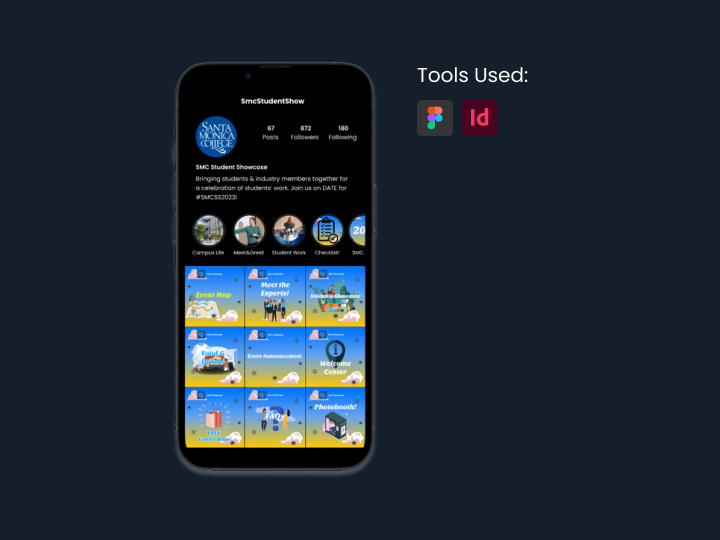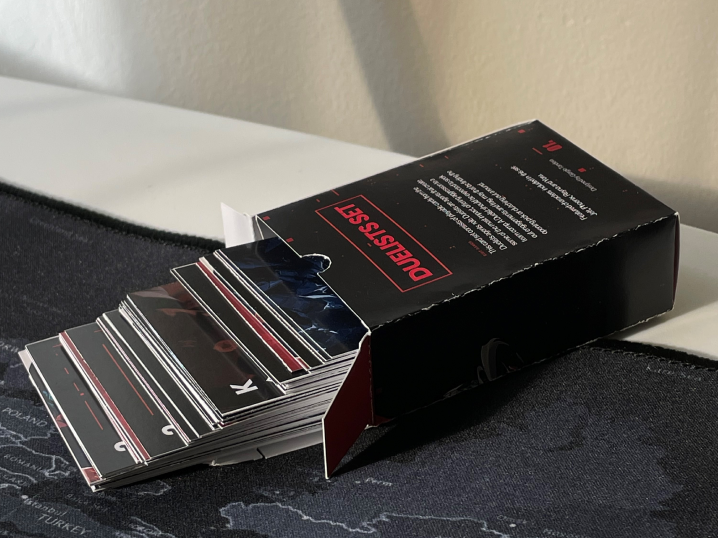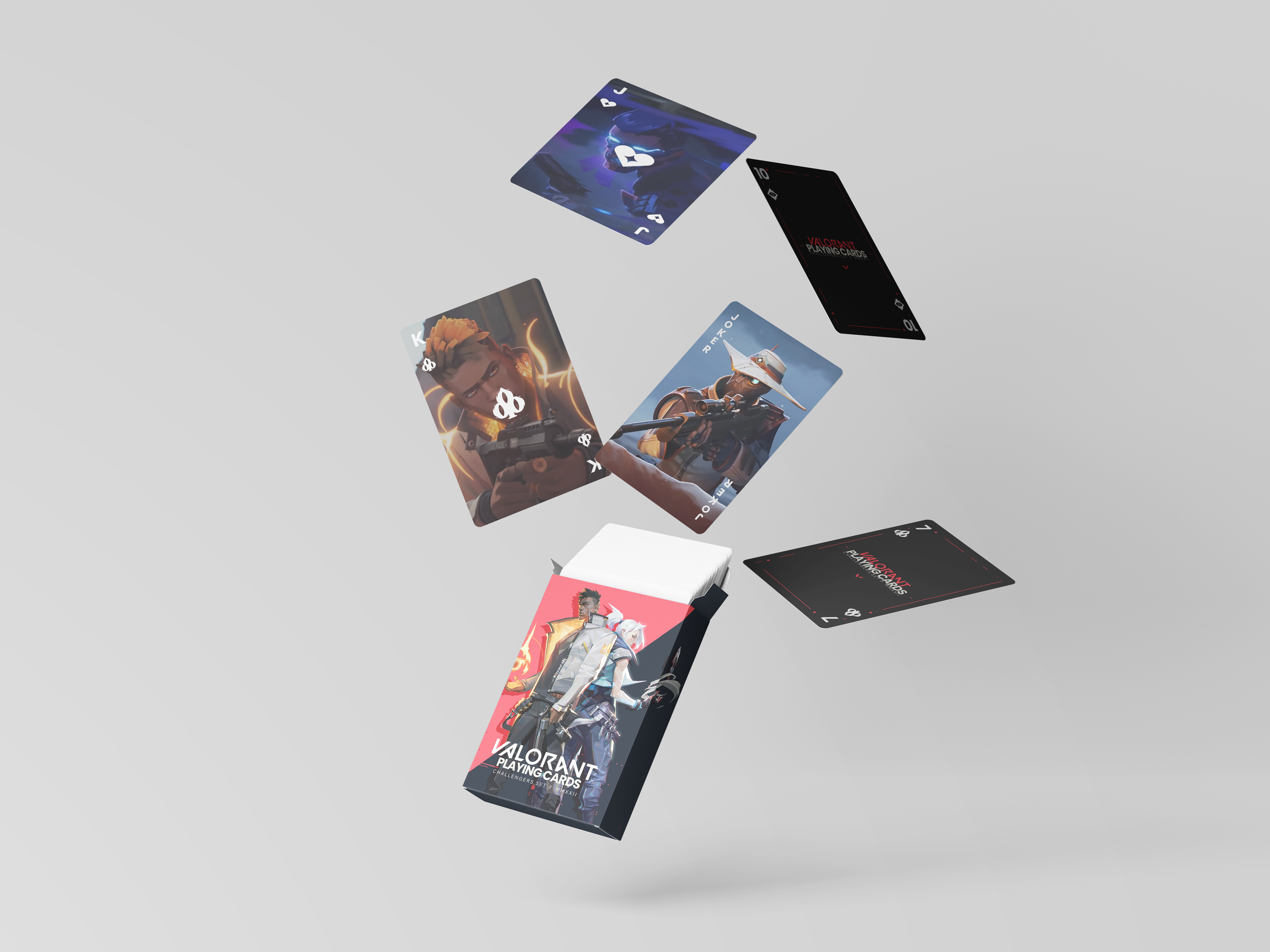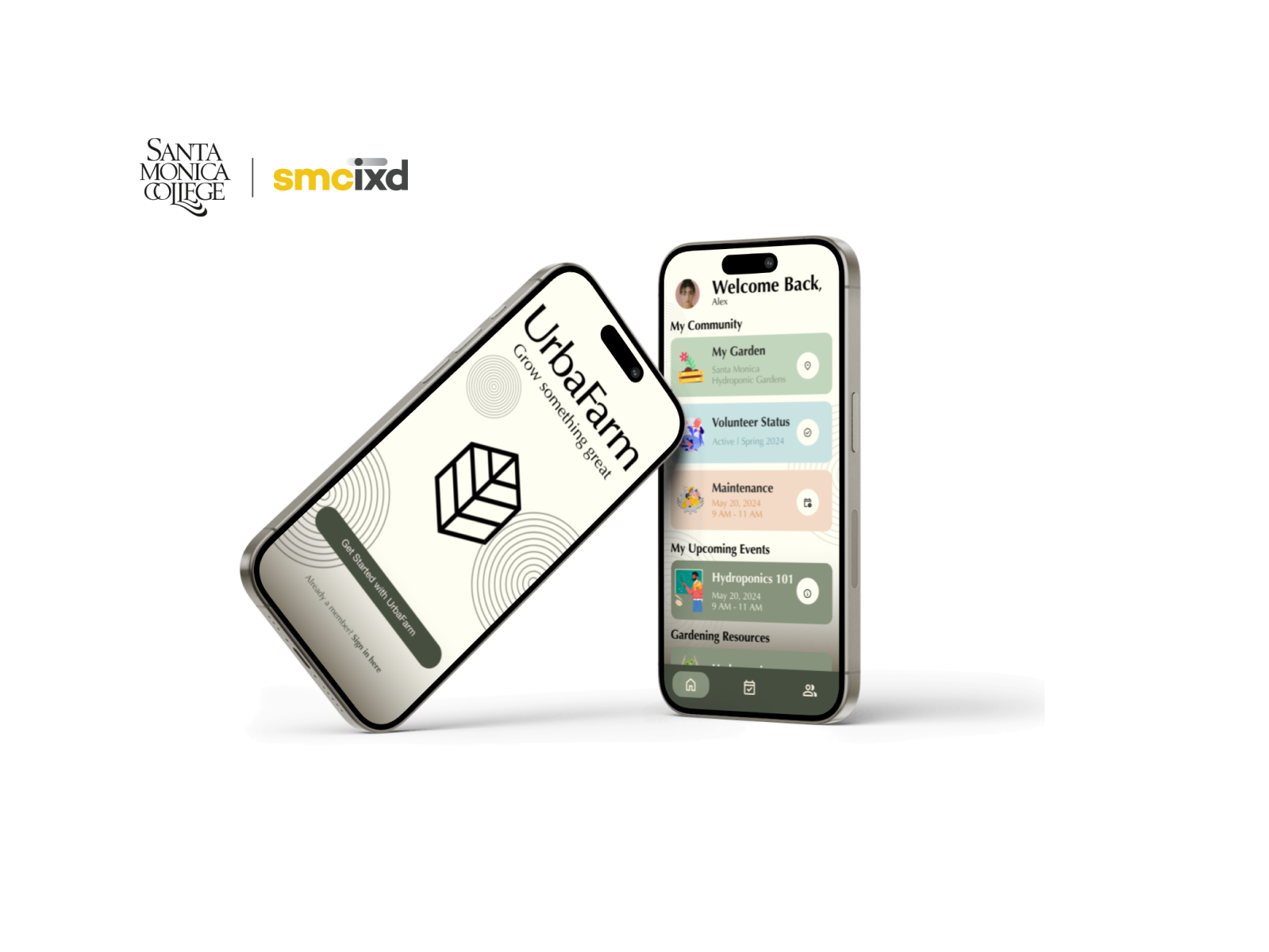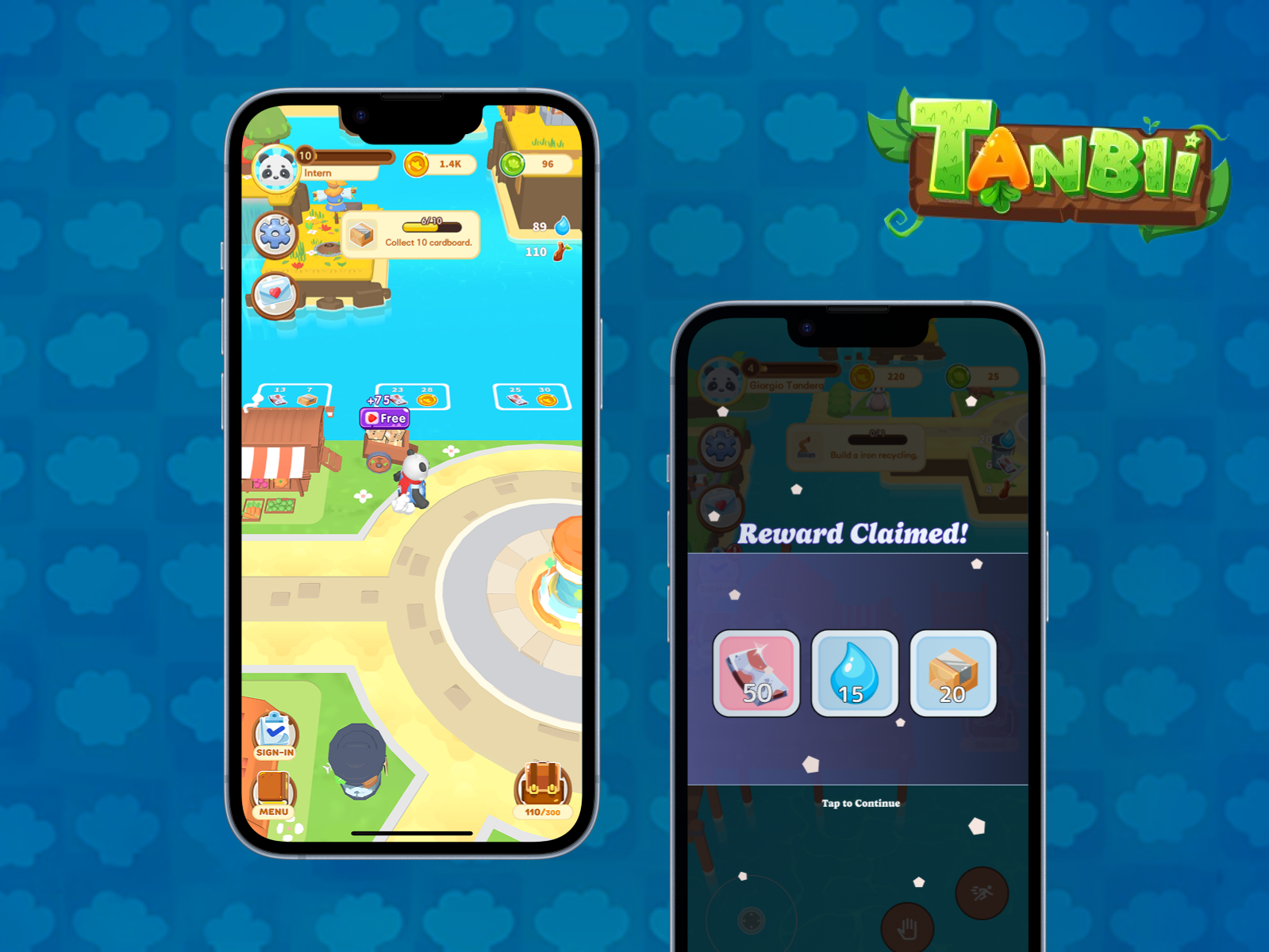PointKyo - Gamified Loyalty App for Cultural and Economic Revitalization in Little Tokyo.
Description: A gamified loyalty app and NFC-enabled accessory transforming Little Tokyo visits into immersive, rewarding adventures. This academic project aimed to address the declining foot traffic and revenue for local businesses while reconnecting visitors with the rich history of culturally significant shops in Little Tokyo.
Academic Project
Role
User Research & Interview, UX Design, Concept Design, User Testing, Team Lead
Year
Fall 2023 (16 Weeks)
Team
Alison Parrales | Birgess Weston | Darren Lau | Giorgio Tandera
For this academic project, we aimed to develop a gamified loyalty app and NFC-enabled accessory to address the declining foot traffic and revenue in Little Tokyo, reconnecting visitors with the rich history of its culturally significant shops.
OVERVIEW / PROJECT CHALLENGE
PointKyo Vision Video | Darren Lau
The Little Tokyo district has faced a steady decline in foot traffic and revenue over the past few years due to various factors, including competing developments nearby, limited accessibility, and a lack of innovative ways to engage younger, tech-savvy visitors. The Pointkyo app was created to address these challenges by introducing a gamified loyalty system aimed at revitalizing local businesses.
PROBLEM
Factors such as limited transportation options, high rental rates for small businesses, and the challenge of attracting a younger demographic to the area have all contributed to this decline.
INSIGHT
Through design ethnography fieldwork and desktop research, we observed that Little Tokyo serves as a hub for leisure, tourism, sightseeing, and shopping. Many visitors struggle with navigating the area due to unclear signage and lack of transportation options. Over 40% of surveyed visitors reported not visiting because they were unaware of local businesses or found parking difficult.
SOLUTION
PointKyo: A gamified loyalty app with NFC-enabled watches/keychains, seamlessly blending technology and culture. This transformative solution not only revitalizes foot traffic and revenue for local businesses but also educates visitors about the deep-rooted history of Little Tokyo's shops. PointKyo serves as a bridge, connecting users with an engaging experience and fostering a renewed appreciation for the cultural tapestry of this cherished community.
Design Challenge
How Might We inform visitors about the rich history of locally-owned businesses in Little Tokyo?
RESEARCH + PROCESS
Observation/ Field Research
Design Ethnography Fieldwork and Observations Insights:
01. Site Usage
Little Tokyo serves as a hub for leisure, tourism, sightseeing, and shopping.
Little Tokyo serves as a hub for leisure, tourism, sightseeing, and shopping.
02. Impact of the Pandemic:
During the pandemic, ridership on L.A. Metro dropped drastically, a reported 70%.
03. Economic Challenges for Local Businesses:
Locally owned stores are experiencing a decline in foot traffic and revenue, leading to store closures.
During field research, I observed that many visitors were unaware of the variety of businesses within Little Tokyo, and many small business owners lacked ways to incentivize repeat visits. This insight led to the creation of the loyalty program within the app
Our Target Audience
These are the people who we are designing for. Our design targets classic millennials and Gen Z individuals in Los Angeles, including students. Our audience consists of Japanese culture enthusiasts, frequent patrons, new explorers, and the dedicated shop owners of Little Tokyo, and together they form a collaborative ecosystem crucial for Little Tokyo's revitalization.
Kenji
Budget-Conscious Japanese Culture Enthusiasts (Millennials/Gen Z)
Jane
New/Regular Visitors of Little Tokyo
John
Store Owners of Local Businesses at Little Tokyo
Ideation
Brainstorming
We pulled out our whiteboard and started to generate creative ideas and potential solutions. We also encourage team collaboration and diverse thinking in class and ended up with our POV Statement to help us set a clear vision or goal.


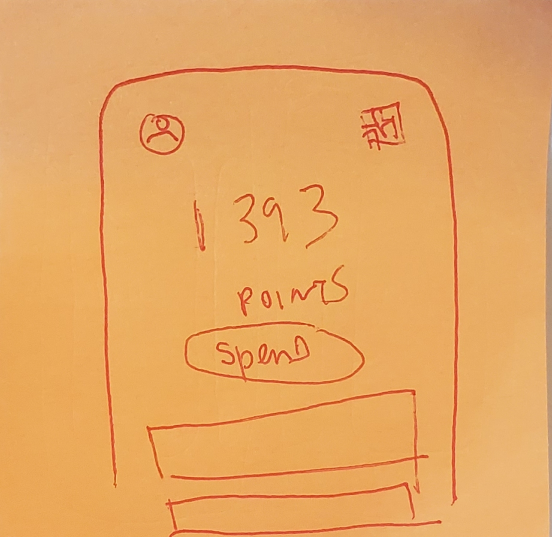
Our POV statement helped us develop initial concepts based on brainstorming sessions, and created a rough sketch illustrating the functionality of PointKyo.
Design Planning
STORYBOARD | Darren Lau
We also thought of bringing PointKyo to life by crafting a storyboard, providing a tangible vision that guided the aesthetic and overall experience of the product.
Prototyping
LOFI WIREFRAMES | Giorgio Tandera

Home Page
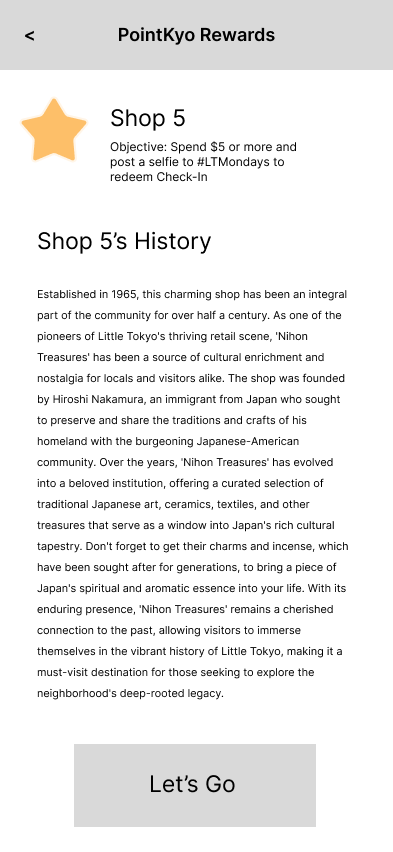
Shop History Page
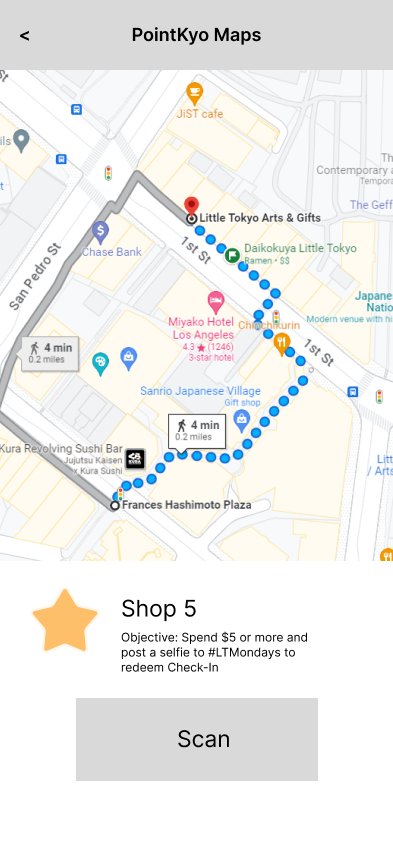
Map Integration

Points System (early)
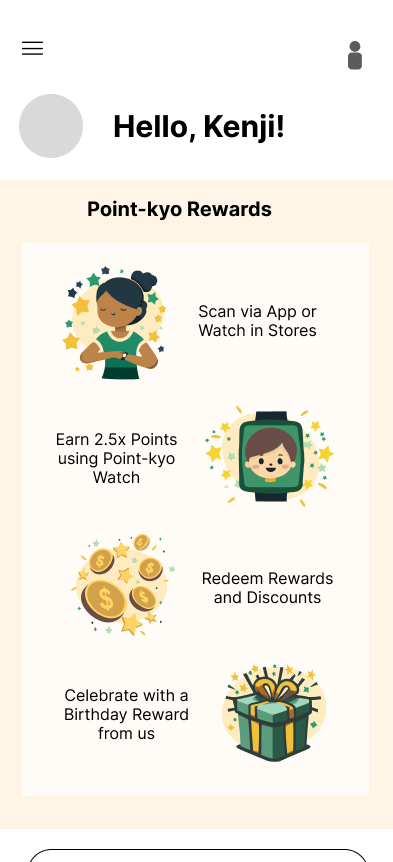
Tips Page
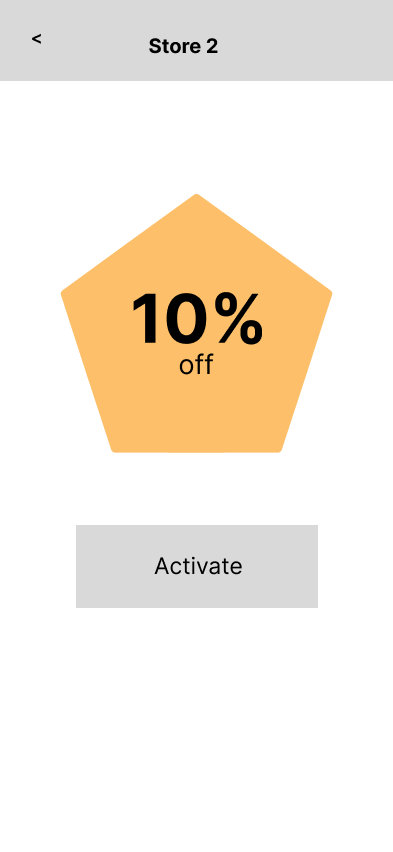
Using Coupon

Redeeming Coupons
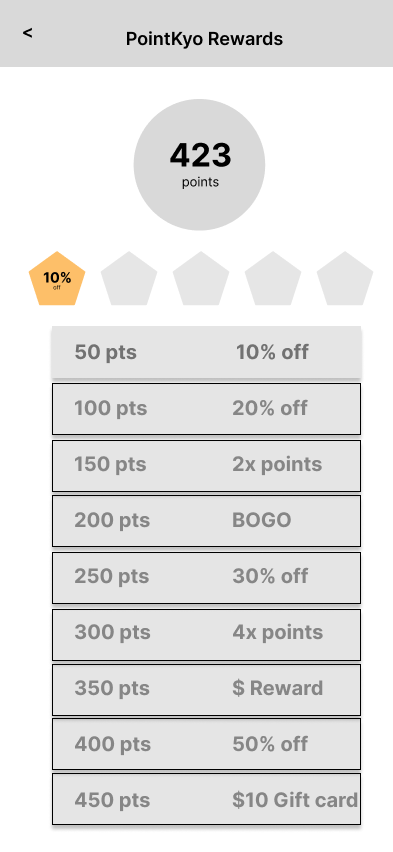
Coupons Page
Next, we entered our low-fidelity prototyping phase with a focus on identifying key design features that could enhance user experience.
Through collaborative brainstorming, the team explored various elements to incorporate into the app, including a reward system, checking in to earn points, exclusive promotions, animations, sound effects, and more.
User Testing
Project Documenting | Alison Parrales


User testing Insights:
Positive Feedback on App Flow and Concept:
Users appreciated the app's flow and historical information, expressing excitement about the daily/weekly plan with rewards.
Suggestions included promoting the app through QR codes in businesses and ensuring compatibility with various devices.
Concerns and Recommendations for Improvement:
During user testing, many users mentioned the need for a quicker onboarding process.
Users raised concerns about the complexity of the app and suggested simplification for a more user-friendly experience.
Questions arose regarding the target audience, attainability of points, and the necessity of the Apple Watch, prompting recommendations for clearer communication and adjustments to the point system.
Design and Functionality Appreciation with Improvement Suggestions:
Users found the app's design easy to use and appreciated its simplicity.
Recommendations included spreading daily goals over a week, providing clearer instructions for earning points, offering various scanning options, and simplifying the rewards system for better user understanding.
Drawing from useful insights gathered during initial user testing within our cohort, we refined our ideas and added features like animations and onboarding pages based on feedback.
These insights led us to refine our NFC-based interactions for quicker, seamless access to the app.
These insights led us to refine our NFC-based interactions for quicker, seamless access to the app.
Refinement / Iteration
NFC was chosen as a unique interaction method because it allowed users to quickly check-in and claim rewards without having to open the app manually, making the experience smoother and more engaging.
Added animation after user feedback
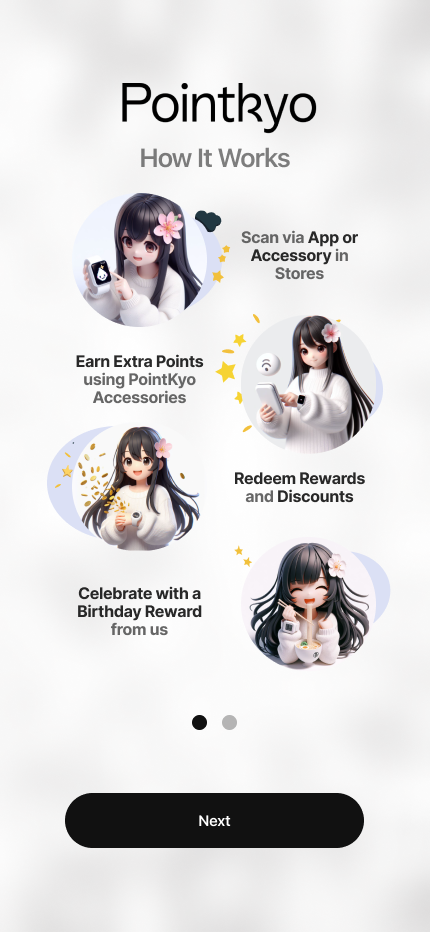
onboarding 1/2
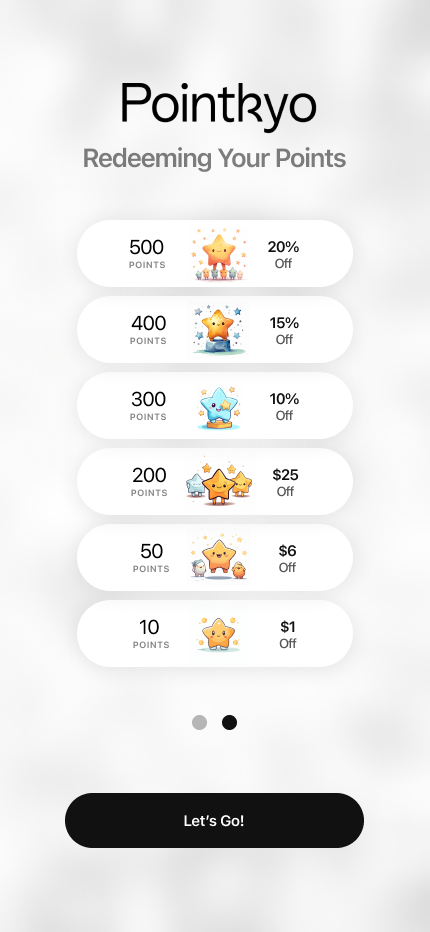
onboarding 2/2
Added onboarding pages
The Solution
Onboarding and Home Page

Onboarding 1/2

Onboarding 2/2
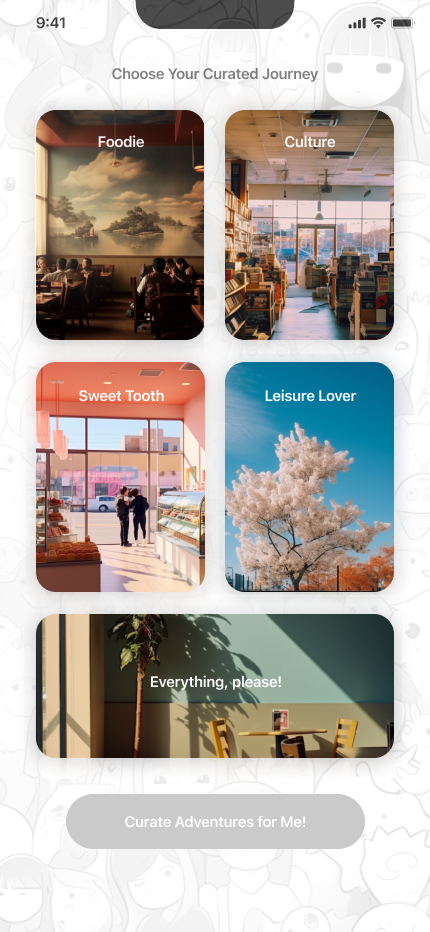
Curating Journey

Home Page Hi-Fi
To start on their PointKyo adventure, users acquire an NFC-enabled accessory, choosing between a stylish watch or a trendy keychain. This accessory becomes their gateway to unlocking the immersive world of PointKyo.
Upon initiation, users are warmly welcomed by an informative onboarding page that guides them through the functionality of PointKyo and introduces the enticing rewards system. Following the onboarding process, users enter a personalized journey customization phase. Here, they have the freedom to choose the type of experience they desire.
Our aim is to lead users beyond the conventional tourist spots, urging them to uncover hidden gems and lesser-known locales. PointKyo is an invitation to delve into the richness of Little Tokyo, providing a unique and rewarding journey that goes beyond the ordinary
Home and Stores Page

Connecting Device
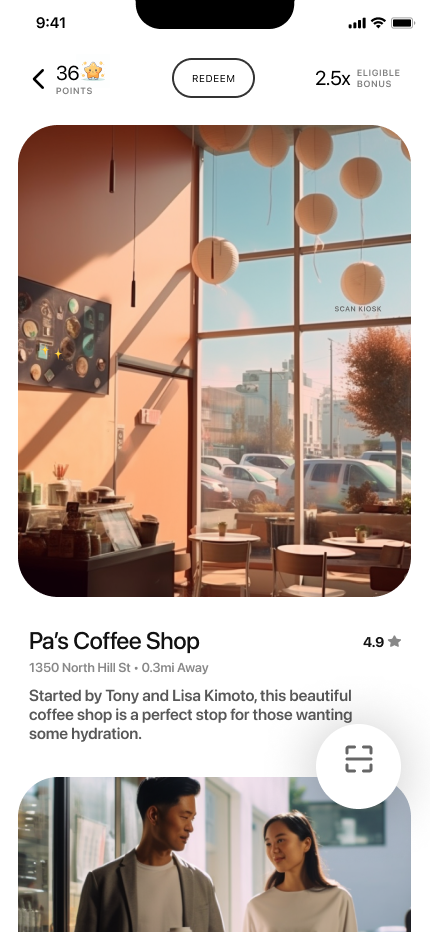
Store Discovery Page
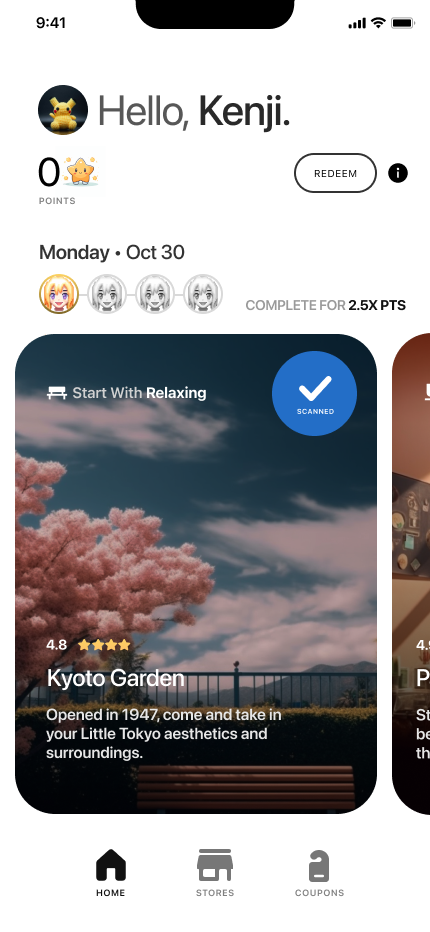
Completing Journey
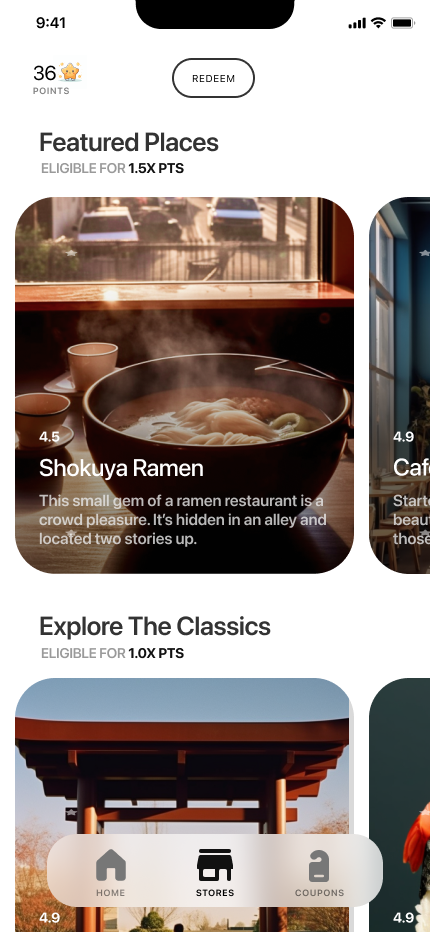
Exploring Store
Enhancing their Little Tokyo adventure, users can seamlessly connect their PointKyo accessory to unlock even more features. Navigating through the app, users can explore a variety of stores by simply clicking on them.
On the Stores page, users gain access to valuable information such as ratings, reviews, and intriguing histories of each participating store. This dedicated page serves as a gateway to discovering the hidden gems of Little Tokyo. As users delve into the unique narratives of each establishment, they are not only enriched culturally but also rewarded with points for their purchases.
Coupons Page

PointKyo Scanning
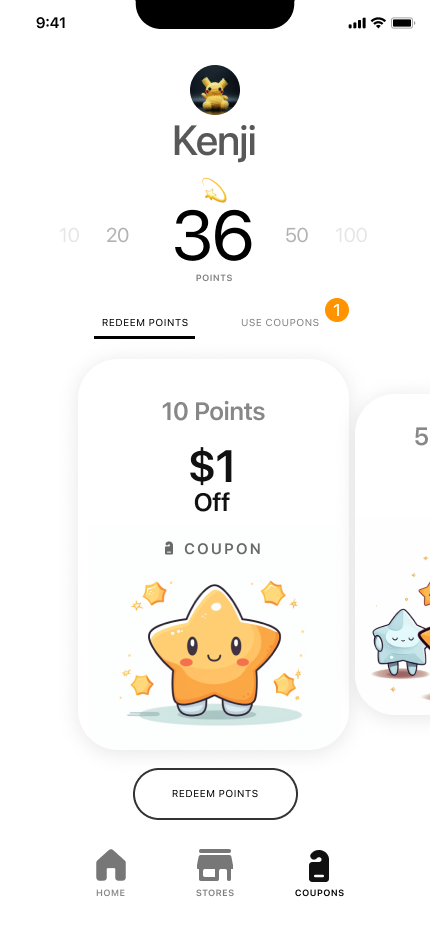
Coupon Page
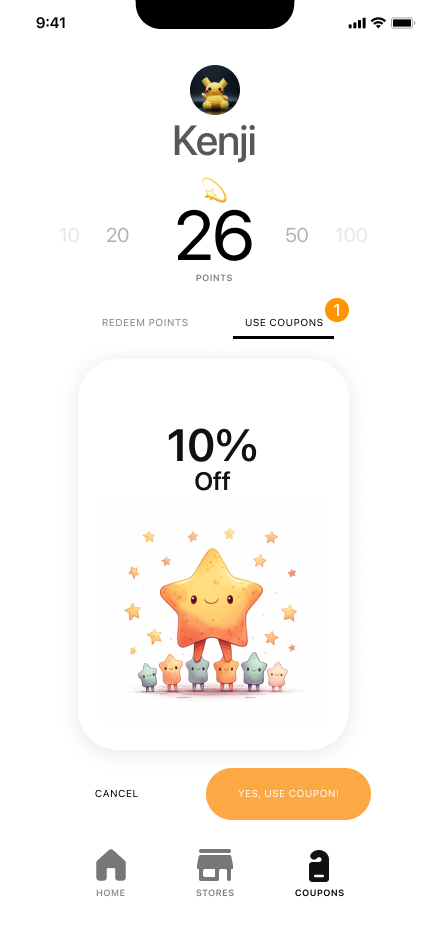
Redeeming Rewards
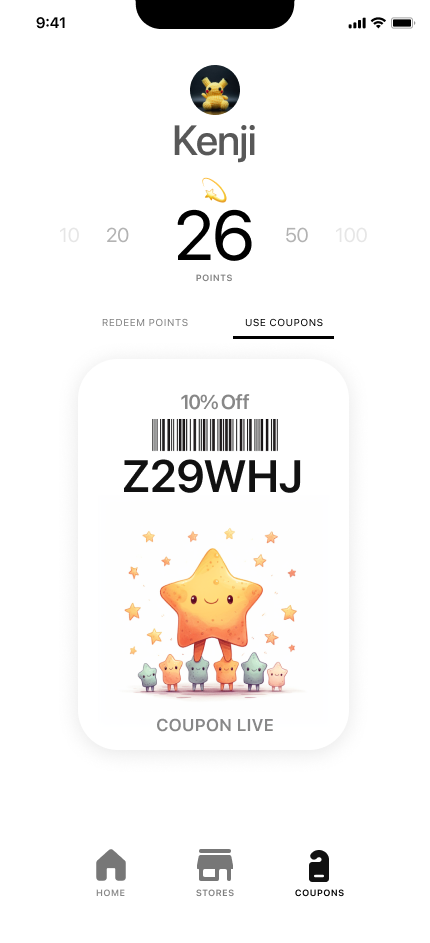
Rewards Code
Users can redeem their accumulated points for exclusive coupons, and unlocking in-store promotions.
PointKyo transforms each point into tangible advantages, fostering a rewarding cycle that elevates not only the user experience but also the vibrancy of local businesses.
REFLECTION
After completing this project I can say that I am more confident in my abilities as a UX designer and as a Design student. I learned a lot of valuable lessons along the way. I see where my skills shine and where it needs refining. I also really appreciated the art of teamwork and everything that comes with it, things like communication, working collaboratively, and designing towards a shared vision.
One surprising thing that usually changes approaches in design projects is user feedback. Users can provide insights and preferences that we hadn't anticipated, demanding a reevaluation of design choices. Adapting to this feedback can lead to more user-centric and successful outcomes.
Constraints and obstacles in design projects can vary differently. Some challenges that we face are tight budgets, time constraints, technology limitations, or unexpected shifts in project scope. Adapting to these constraints usually involves prioritizing key features, finding creative solutions, and maintaining open communication with stakeholders.
Looking back, I wish I had implemented more comprehensive user testing earlier in the design process to identify potential issues and preferences sooner. Additionally, I could have maintained a more flexible design approach, being open to feedback, and proactively addressing constraints can contribute to a smoother project trajectory.
Looking back, I wish I had implemented more comprehensive user testing earlier in the design process to identify potential issues and preferences sooner. Additionally, I could have maintained a more flexible design approach, being open to feedback, and proactively addressing constraints can contribute to a smoother project trajectory.
Some possible next steps to follow up could be further developing a marketing plan with posters showcasing PointKyo's coupons, to bring potential customers, further developing the app with updates and special promotions, and finding out the logistics of how we are going to produce and sell the accessories.

